Endangered Sea Turtle
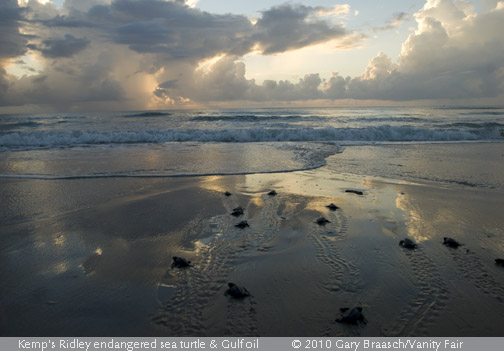
Reflections on the fate of the most endangered sea turtle, the Kemp's Ridley, Lepidochelys kempii, whose juvenile habitat is centered in the oil spill area. A Portfolio from an assignment for Vanity Fair, with story by Alex Shoumatoff, now online at VanityFair.com. During the oil spill more 580 sea turtles were found dead and about 530 alive, with most of those being oiled. Most turtles caught or found were Kemp's ridleys. In this photo, newly hatched Kemp's ridley turtles head into the Gulf from their Mexican hatching beach, swimming straight toward the oil industry's center off Louisiana. Featured on Vanity Fair home page Sept 20, 2010
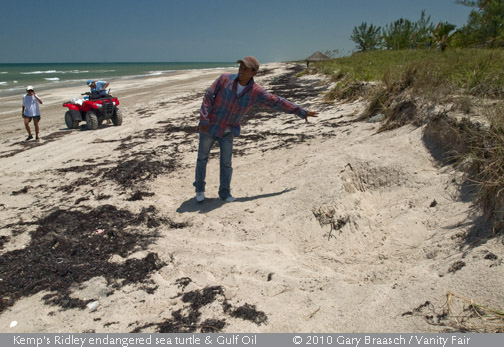
Along the main nesting beach and hatching area for 95 percent of Kemp's ridley turtles, Playa Rancho Nuevo, Mexico, the beach patrol checks out a nest. In 2009 there were 21,000 nests. Six thousand females came ashore over a two-day period that May, the biggest arribada in the 40-year history of the conservation program at Rancho Nuevo. But this year there were only 13,115 nests, apparently due to cold and a red tide, and about 12,000 nests produced hatchlings. The turtle has been protected since the 1970s after populations dropped from 42,000 nesting females to only a few hundred.
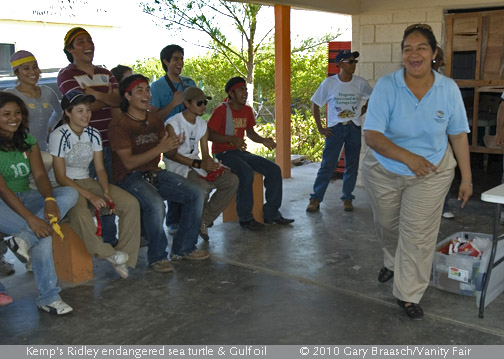
At Playa Rancho Nuevo, Dr. Gloria Tavera and staff plus staff from Gladys Porter Zoo in Brownsville TX, greets student volunteers who who help protect and manage the thousands of nests laid by endangered Kemp's ridley sea turtles. This year was particularly important since the baby turtles swim directly east out into the Gulf to reach sargassum sea weed habitat -- which is also the area with about 4000 oil and gas rigs, and which was polluted by the BP oil spill. About 750,000 hatchlings swam out from Rancho Nuevo this year --- only one in a thousand will survive to maturity and, if female, return to the beach of its birth.
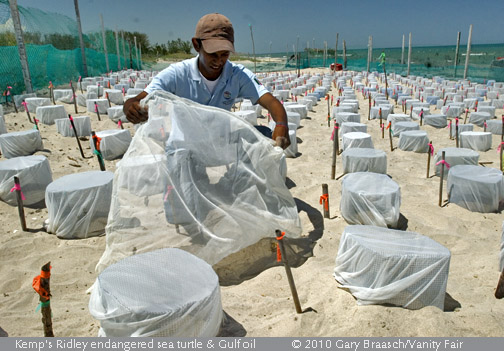
Marco Antonio Castro Martinez, supervisor of the hatching and patrolling of the beaches at Playa Rancho Nuevo, putting netting over one of more than 800 nests relocated to this protected "corral" after being laid by female Kemp's ridley sea turtles. Kemp's Ridley sea turtle main nesting ground and hatching area, Playa Rancho Nuevo, is a Mexican national reserve, where Dr. Gloria Tavera and staff, plus staff from Gladys Porter Zoo in Brownsville TX and students protect and manage eggs laid.
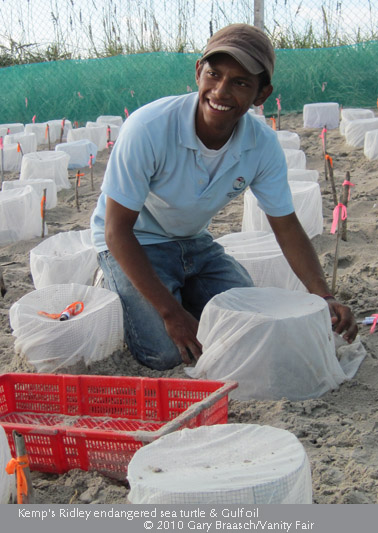
Marco Antonio Castro Martinez, supervisor of the hatching and patrolling of the beaches at Kemp's Ridley sea turtle main nesting ground and hatching area, Playa Rancho Nuevo, a Mexican national reserve. He is putting netting over one of 800 nests in one of three relocation areas established to protect the eggs from predation and storm waves.
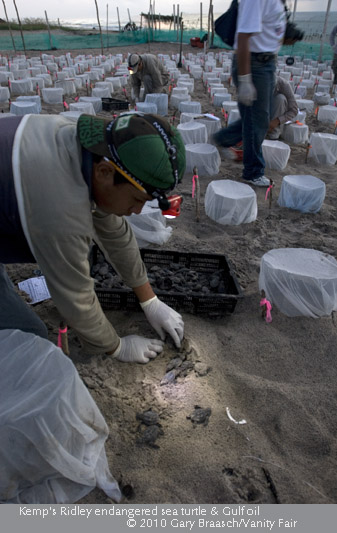
Staff member of the Mexican national reserve for Kemp's ridley sea turtles gathers hatchling turtles at dawn from one of more than 800 nests relocated after being laid by females up to June 3, 2010. In total more than 13,000 nests were laid this year. On July 17, the staff gathered hatching turtles from about 80 nests and released more than 3000 hatchlings into the Gulf of Mexico. Kemp's Ridley sea turtle main nesting ground and hatching area, Playa Rancho Nuevo Sanctuary, a Mexican national reserve.
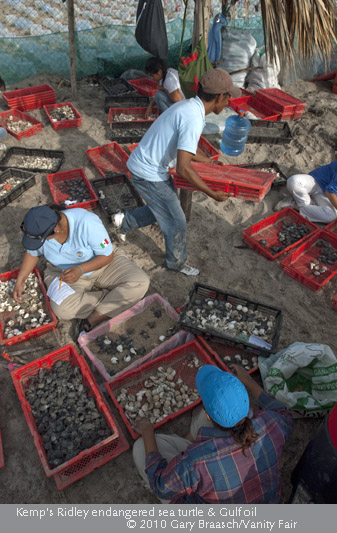
As hatching of tiny turtles proceeds at "corral" which protects Kemp's ridley sea turtle eggs from predation and storms, reserve staff and volunteers are sorting eggs to find any turtles which could still survive. Careful protection and study like this at the sea turtle's main nesting ground and hatching area, Playa Rancho Nuevo, Mexico, have helped to increase the estimated number of these most endangered turtles from about 600 nesting females in the 1980s to more than 6000 in recent years.
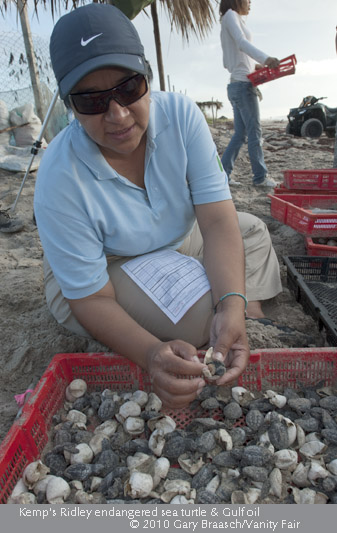
Director of the Playa Rancho Nuevo reserve, Dr. Gloria Tavera, studying a partially hatched egg and turtle hatchling from the south corral of nests, during hatching of about 80 nests on July 17, 2010. This turtle is not viable because it has not absorbed its egg sack, but others that are not quite ready are incubated for later release to the sea. Careful protection and study like this have helped to increase the estimated number of these most endangered turtles from about 600 nesting females in the 1980s to more than 6000 in recent years.
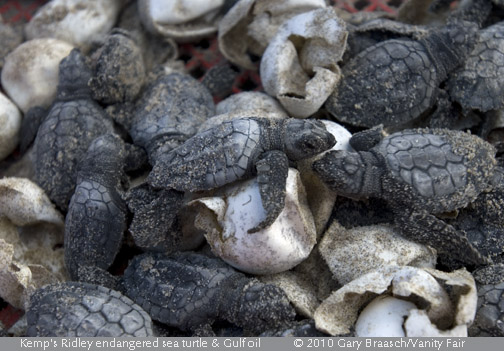
Hatchlings not completely out of shells are rescued and will be taken to incubator to complete their development for release in several hours to several days. Careful protection and study like this have helped to increase the estimated number of these most endangered turtles from about 600 nesting females in the 1980s to more than 6000 in recent years. Kemp's Ridley sea turtle main nesting ground and hatching area is Playa Rancho Nuevo, a Mexican national reserve.
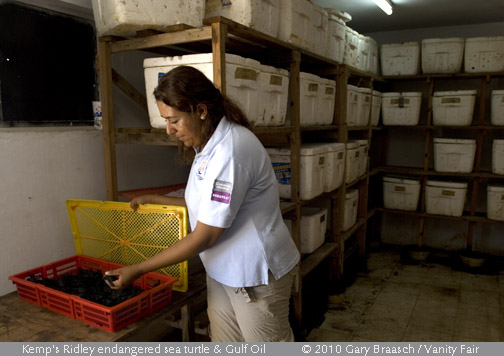
Christina Lovano, staff member, in incubation room at the Kemp's Ridley sea turtle main nesting ground and hatching area, Playa Rancho Nuevo, a Mexican national reserve. Hatchlings from protected relocated nests and incubators are collected in trays and let loose toward the surf of the Gulf of Mexico on beach in early mornings.
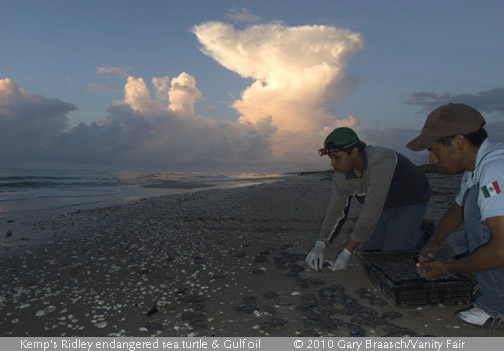
Marco Antonio Castro Martinez, supervisor of the hatching, and staff member set some of about 3000 newly hatched turtles loose toward sea at dawn, July 17, 2010, at Playa Rancho Nuevo Mexico. This is Kemp's Ridley sea turtle main nesting ground and hatching area, a Mexican national reserve, where 13,000 nests were laid in 2010, and about 12,000 produced hatchlings. The baby turtles swim directly out into the Gulf to reach sargassum sea weed habitat -- which is also the area with about 4000 oil and gas rigs, and which was polluted by the BP oil spill.
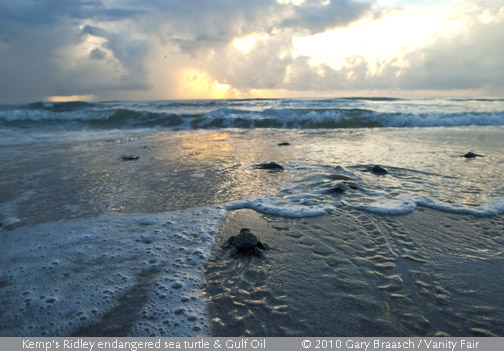
Some of about 3000 newly hatched turtles reach the Gulf of Mexico surf at dawn, July 17, 2010, at Playa Rancho Nuevo, Mexico. This is Kemp's Ridley sea turtle main nesting ground and hatching area, a Mexican national reserve, where 13,000 nests were laid in 2010, and about 12,000 produced more than 700,000 hatchlings. The baby turtles swim directly out into the Gulf to reach sargassum sea weed, their prime juvenile habitat -- which is also the area with about 4000 oil and gas rigs, and which was polluted by the BP oil spill.
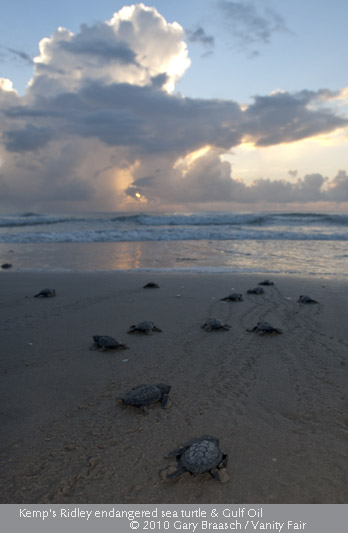
Some of about 3000 newly hatched Kemp's ridley turtles crawl toward sea at dawn, July 17, 2010, at Playa Rancho Nuevo, Mexico, the endangered sea turtle's main nesting ground and hatching area. 13,000 nests were laid in 2010, and about 12,000 produced hatchlings. The baby turtles swim directly out into the Gulf to reach sargassum sea weed habitat -- which is also the area with about 4000 oil and gas rigs, and which was polluted by the BP oil spill.
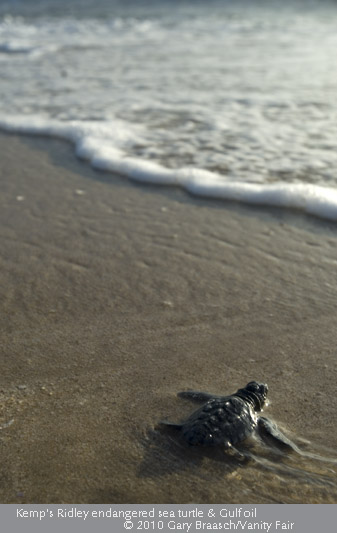
One of the thousands of hatchling Kemp's ridley sea turtles reaching the Gulf of Mexico at their main nesting ground, and hatching area near Tampico Mexico. In 2009 there were 21,000 nests. But this year there were only about 12,000 nests, apparently due to cold, a red tide and storms. There are about 60 hatchlings per nest, and only one hatchling per thousand is estimated to make it to maturity. The Kemp's ridley, Lepidochelys kempii, is the most endangered of the sea turtles of the Gulf. Its juvenile habitat is centered in the oil spill area.
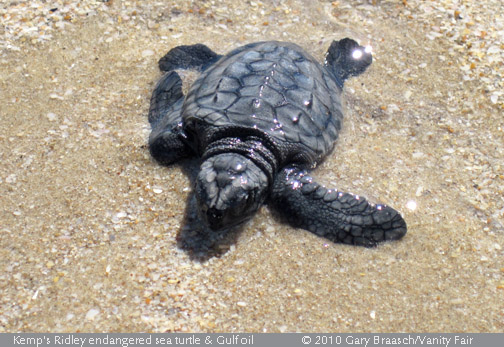
One of the tiny hatchling Kemp's ridley sea turtles, three inches long, makes its way across the Mexican beach where it was born, July 17, 2010. This is their main nesting ground, and hatching area, Playa Rancho Nuevo, a Mexican national reserve. In 2009 there were 21,000 nests. But this year there were only about 12,000 nests, apparently due to cold, a red tide and storms. There are about 60 hatchlings per nest, and only one hatchling per thousand is estimated to make it to maturity.
Photo Reports Intro
1. The BP Deepwater Horizon oil well gushes crude across the Gulf to beaches and marsh.
2. Crude comes ashore from Gulf Shores to Grand Isle.
3. Clean up workers and local people react to the oil.
4. Oil in the marshes greases up birds and sedges; fishing and shrimping are closed.
5. Shrimping and fishing begin to return but long term effects of oil remain.
5A. The toll on animals and birds continues; rescuers take action.
6. Indians Face Oil Spill
7. Indians Face Oil Spill 2
8. The most endangered sea turtle and the Gulf oil spill 1
9. The most endangered sea turtle and the Gulf oil spill 2
COPYRIGHT NOTICE:
Photography and text Copyright © 2005 - 2017 (and before) Gary Braasch All rights reserved. Use of photographs in any manner without permission is prohibited by US copyright law. Photography is available for license to publications and other uses. Please contact requestinformation@worldviewofglobalwarming.org. View more of Gary Braasch's photography here.


